Inpage Navigation Section: Overview
Make Your Statement with the all-new Ninja 500 sportbike. Turn heads with the aggressive styling Ninja sportbikes are known for and set the tone with a 451cc twin-cylinder engine. Experience legendary Ninja performance on the sportbike designed to lead the crowd.
Colours
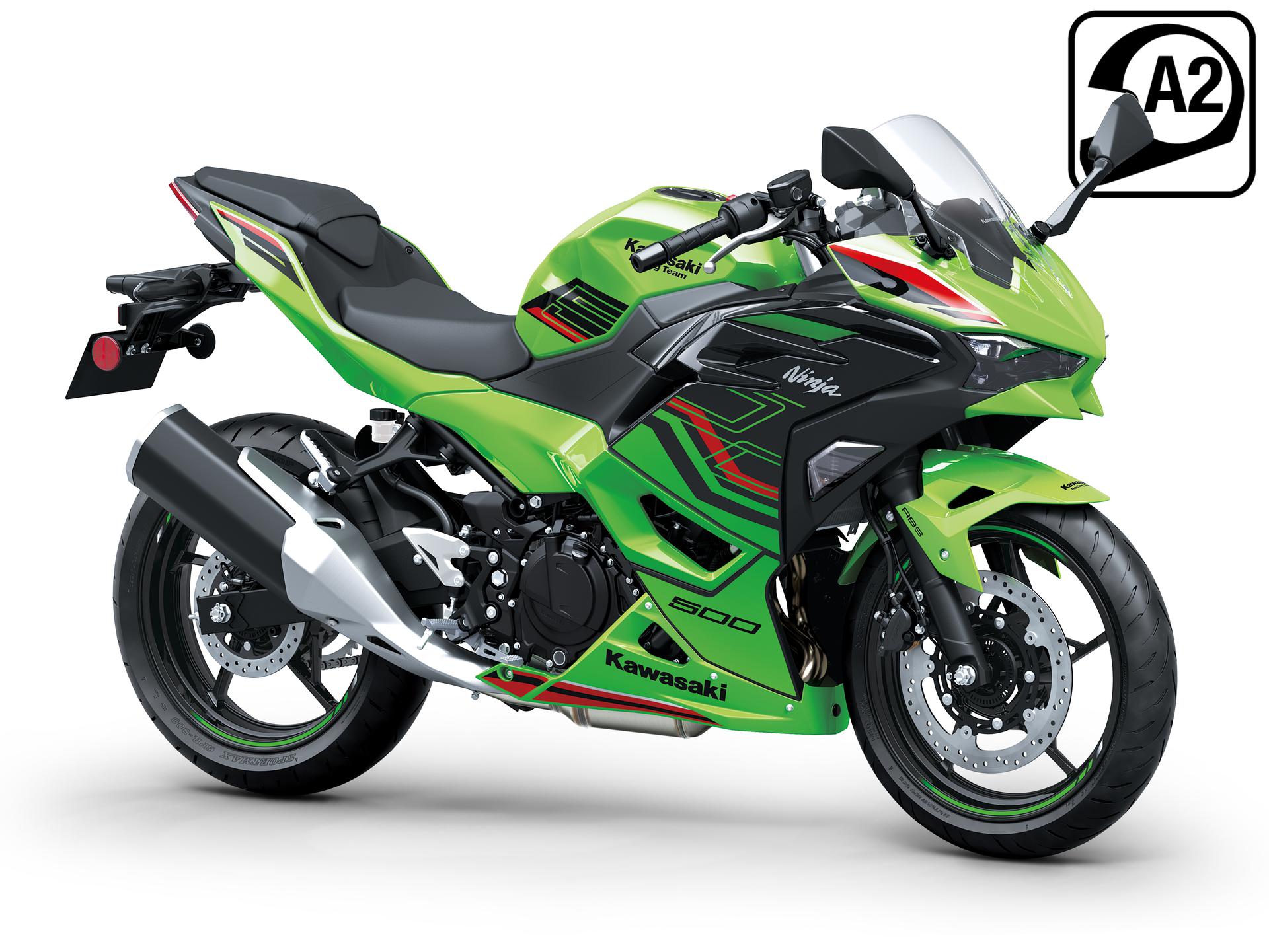
Show all
Show less
Inpage Navigation Section: Gallery




















Inpage Navigation Section: Features & Specs
Easy to use is the key, as the compact chassis has been designed to be as user-friendly as possible. Predictable handling thanks to a chassis conceived with light weight, maneuverability, and mass centralization in mind provides excellent feel and inspiring confidence for a wide range of riders. The easy handling also facilitates maneuvering when parking.

Easy to use is the key, as the compact chassis has been designed to be as user-friendly as possible. Predictable handling thanks to a chassis conceived with light weight, maneuverability, and mass centralization in mind provides excellent feel and inspiring confidence for a wide range of riders. The easy handling also facilitates maneuvering when parking.
Smooth, powerful acceleration is available with a twist of the wrist from a new 451 cm3 engine. The acceleration feels brisk thanks to plenty of power in the low- to mid-rpm range, and, when the throttle stays on, enough power in the high-rpm range to hit higher speeds with ease. With well-balanced power output and strong acceleration throughout the rev range, the combination of this engine with a lightweight chassis makes the machine well-suited to a wide variety of riding situations including everyday riding.

Smooth, powerful acceleration is available with a twist of the wrist from a new 451 cm3 engine. The acceleration feels brisk thanks to plenty of power in the low- to mid-rpm range, and, when the throttle stays on, enough power in the high-rpm range to hit higher speeds with ease. With well-balanced power output and strong acceleration throughout the rev range, the combination of this engine with a lightweight chassis makes the machine well-suited to a wide variety of riding situations including everyday riding.
No matter from what angle the Ninja 500 is seen, its distinctive front face and sleek, flowing lines make it clear that this is a member of the Ninja family, with race-inspired, big-bike looks. The shape of the full-fairing bodywork fosters a sense of unity with the rider, helping them feel at one with the bike.

No matter from what angle the Ninja 500 is seen, its distinctive front face and sleek, flowing lines make it clear that this is a member of the Ninja family, with race-inspired, big-bike looks. The shape of the full-fairing bodywork fosters a sense of unity with the rider, helping them feel at one with the bike.
KIPASS (Kawasaki’s Intelligent Proximity Activation Start System) is a master key system that allows remote activation of the bike’s main switch and steering lock.

KIPASS (Kawasaki’s Intelligent Proximity Activation Start System) is a master key system that allows remote activation of the bike’s main switch and steering lock.
The Ninja 500 SE features a high-grade full colour display with TFT (thin-film transistor) technology, delivering a high level of visibility. The screen’s background colour is selectable (black or white), and screen brightness adjusts automatically to suit available light.

The Ninja 500 SE features a high-grade full colour display with TFT (thin-film transistor) technology, delivering a high level of visibility. The screen’s background colour is selectable (black or white), and screen brightness adjusts automatically to suit available light.
While seat height is 785 mm, the slim design of both the seat and the rear of the engine gives riders an unobstructed line for their feet to reach the ground. The seat’s flat shape offers ample padding in the front portion without sacrificing the comfortable reach to the ground, which helps riders enjoy the bike with confidence.

While seat height is 785 mm, the slim design of both the seat and the rear of the engine gives riders an unobstructed line for their feet to reach the ground. The seat’s flat shape offers ample padding in the front portion without sacrificing the comfortable reach to the ground, which helps riders enjoy the bike with confidence.
Relaxed rider triangle accommodates a wide range of rider sizes and riding situations. Compared to some other models (whose somewhat extreme riding position compromises comfort), the elevated handle position and slightly foot-forward footpeg position put the rider in a position to control the bike while also offering rider comfort.

Relaxed rider triangle accommodates a wide range of rider sizes and riding situations. Compared to some other models (whose somewhat extreme riding position compromises comfort), the elevated handle position and slightly foot-forward footpeg position put the rider in a position to control the bike while also offering rider comfort.
Seats with thick cushioning and low-rebound urethane contribute to superb ride comfort. The Ninja 500’s large volume bodywork also offers great wind protection, further contributing to ride comfort.

Seats with thick cushioning and low-rebound urethane contribute to superb ride comfort. The Ninja 500’s large volume bodywork also offers great wind protection, further contributing to ride comfort.
The Ninja 500 features a trellis frame similar in design to that of the Ninja H2. Kawasaki’s advanced dynamic rigidity analysis was used to ensure optimum rigidity with light weight. The engine is rigid-mounted and used as a stressed member. The frame design contributes significantly to the bike’s low curb mass.

The Ninja 500 features a trellis frame similar in design to that of the Ninja H2. Kawasaki’s advanced dynamic rigidity analysis was used to ensure optimum rigidity with light weight. The engine is rigid-mounted and used as a stressed member. The frame design contributes significantly to the bike’s low curb mass.
The chassis has a supersport-style short-wheelbase/long swingarm design, complemented by an optimized trail setting that delivers light, natural handling. The bike’s light weight also contributes to easy handling and facilitates maneuvering when off the bike, such as when parking.

The chassis has a supersport-style short-wheelbase/long swingarm design, complemented by an optimized trail setting that delivers light, natural handling. The bike’s light weight also contributes to easy handling and facilitates maneuvering when off the bike, such as when parking.
Kawasaki’s Assist & Slipper Clutch results in a light clutch pull for even more rider-friendly and manageable riding in everyday situations, and reduced skipping and hopping from the rear for better sport riding and added confidence.

Kawasaki’s Assist & Slipper Clutch results in a light clutch pull for even more rider-friendly and manageable riding in everyday situations, and reduced skipping and hopping from the rear for better sport riding and added confidence.
The power available from the 451 cm3 engine is found through the entire rpm range to make it easy for riders to use, no matter what kind of riding they are doing, from low-end power for accelerating off the line in the city to top end revs for riding on the highway. The engine in the new Ninja 500 is up the task, no matter what it may be.

The power available from the 451 cm3 engine is found through the entire rpm range to make it easy for riders to use, no matter what kind of riding they are doing, from low-end power for accelerating off the line in the city to top end revs for riding on the highway. The engine in the new Ninja 500 is up the task, no matter what it may be.
Both the full LCD instrument panel on the standard models and the TFT display on the SE models offer smartphone connectivity, enabling riders to connect with their machines to enjoy display notifications, riding logs, and community features.

Both the full LCD instrument panel on the standard models and the TFT display on the SE models offer smartphone connectivity, enabling riders to connect with their machines to enjoy display notifications, riding logs, and community features.
The Ninja 500’s “face” is based around two newly designed compact headlights. Below them two spoilers protrude forward and complete the striking look.

The Ninja 500’s “face” is based around two newly designed compact headlights. Below them two spoilers protrude forward and complete the striking look.
Moving from front to rear with a flowing, layered design, the bodywork on the new Ninja 500 offers a fresh impression, while sporty elements give the machine a purposeful, race-inspired look that owners will be proud to own and show off.

Moving from front to rear with a flowing, layered design, the bodywork on the new Ninja 500 offers a fresh impression, while sporty elements give the machine a purposeful, race-inspired look that owners will be proud to own and show off.
Measuring Ø 310 mm (the same disc size used on the Ninja ZX-14R), the Ninja 500’s semi-floating front disc offers sure stopping power. ABS models offer added reassurance when riding.

Measuring Ø 310 mm (the same disc size used on the Ninja ZX-14R), the Ninja 500’s semi-floating front disc offers sure stopping power. ABS models offer added reassurance when riding.
Easy to use is the key, as the compact chassis has been designed to be as user-friendly as possible. Predictable handling thanks to a chassis conceived with light weight, maneuverability, and mass centralization in mind provides excellent feel and inspiring confidence for a wide range of riders. The easy handling also facilitates maneuvering when parking.

Easy to use is the key, as the compact chassis has been designed to be as user-friendly as possible. Predictable handling thanks to a chassis conceived with light weight, maneuverability, and mass centralization in mind provides excellent feel and inspiring confidence for a wide range of riders. The easy handling also facilitates maneuvering when parking.
Smooth, powerful acceleration is available with a twist of the wrist from a new 451 cm3 engine. The acceleration feels brisk thanks to plenty of power in the low- to mid-rpm range, and, when the throttle stays on, enough power in the high-rpm range to hit higher speeds with ease. With well-balanced power output and strong acceleration throughout the rev range, the combination of this engine with a lightweight chassis makes the machine well-suited to a wide variety of riding situations including everyday riding.

Smooth, powerful acceleration is available with a twist of the wrist from a new 451 cm3 engine. The acceleration feels brisk thanks to plenty of power in the low- to mid-rpm range, and, when the throttle stays on, enough power in the high-rpm range to hit higher speeds with ease. With well-balanced power output and strong acceleration throughout the rev range, the combination of this engine with a lightweight chassis makes the machine well-suited to a wide variety of riding situations including everyday riding.
No matter from what angle the Ninja 500 is seen, its distinctive front face and sleek, flowing lines make it clear that this is a member of the Ninja family, with race-inspired, big-bike looks. The shape of the full-fairing bodywork fosters a sense of unity with the rider, helping them feel at one with the bike.

No matter from what angle the Ninja 500 is seen, its distinctive front face and sleek, flowing lines make it clear that this is a member of the Ninja family, with race-inspired, big-bike looks. The shape of the full-fairing bodywork fosters a sense of unity with the rider, helping them feel at one with the bike.
KIPASS (Kawasaki’s Intelligent Proximity Activation Start System) is a master key system that allows remote activation of the bike’s main switch and steering lock.

KIPASS (Kawasaki’s Intelligent Proximity Activation Start System) is a master key system that allows remote activation of the bike’s main switch and steering lock.
The Ninja 500 SE features a high-grade full colour display with TFT (thin-film transistor) technology, delivering a high level of visibility. The screen’s background colour is selectable (black or white), and screen brightness adjusts automatically to suit available light.

The Ninja 500 SE features a high-grade full colour display with TFT (thin-film transistor) technology, delivering a high level of visibility. The screen’s background colour is selectable (black or white), and screen brightness adjusts automatically to suit available light.
While seat height is 785 mm, the slim design of both the seat and the rear of the engine gives riders an unobstructed line for their feet to reach the ground. The seat’s flat shape offers ample padding in the front portion without sacrificing the comfortable reach to the ground, which helps riders enjoy the bike with confidence.

While seat height is 785 mm, the slim design of both the seat and the rear of the engine gives riders an unobstructed line for their feet to reach the ground. The seat’s flat shape offers ample padding in the front portion without sacrificing the comfortable reach to the ground, which helps riders enjoy the bike with confidence.
Relaxed rider triangle accommodates a wide range of rider sizes and riding situations. Compared to some other models (whose somewhat extreme riding position compromises comfort), the elevated handle position and slightly foot-forward footpeg position put the rider in a position to control the bike while also offering rider comfort.

Relaxed rider triangle accommodates a wide range of rider sizes and riding situations. Compared to some other models (whose somewhat extreme riding position compromises comfort), the elevated handle position and slightly foot-forward footpeg position put the rider in a position to control the bike while also offering rider comfort.
Seats with thick cushioning and low-rebound urethane contribute to superb ride comfort. The Ninja 500’s large volume bodywork also offers great wind protection, further contributing to ride comfort.

Seats with thick cushioning and low-rebound urethane contribute to superb ride comfort. The Ninja 500’s large volume bodywork also offers great wind protection, further contributing to ride comfort.
The Ninja 500 features a trellis frame similar in design to that of the Ninja H2. Kawasaki’s advanced dynamic rigidity analysis was used to ensure optimum rigidity with light weight. The engine is rigid-mounted and used as a stressed member. The frame design contributes significantly to the bike’s low curb mass.

The Ninja 500 features a trellis frame similar in design to that of the Ninja H2. Kawasaki’s advanced dynamic rigidity analysis was used to ensure optimum rigidity with light weight. The engine is rigid-mounted and used as a stressed member. The frame design contributes significantly to the bike’s low curb mass.
The chassis has a supersport-style short-wheelbase/long swingarm design, complemented by an optimized trail setting that delivers light, natural handling. The bike’s light weight also contributes to easy handling and facilitates maneuvering when off the bike, such as when parking.

The chassis has a supersport-style short-wheelbase/long swingarm design, complemented by an optimized trail setting that delivers light, natural handling. The bike’s light weight also contributes to easy handling and facilitates maneuvering when off the bike, such as when parking.
Kawasaki’s Assist & Slipper Clutch results in a light clutch pull for even more rider-friendly and manageable riding in everyday situations, and reduced skipping and hopping from the rear for better sport riding and added confidence.

Kawasaki’s Assist & Slipper Clutch results in a light clutch pull for even more rider-friendly and manageable riding in everyday situations, and reduced skipping and hopping from the rear for better sport riding and added confidence.
The power available from the 451 cm3 engine is found through the entire rpm range to make it easy for riders to use, no matter what kind of riding they are doing, from low-end power for accelerating off the line in the city to top end revs for riding on the highway. The engine in the new Ninja 500 is up the task, no matter what it may be.

The power available from the 451 cm3 engine is found through the entire rpm range to make it easy for riders to use, no matter what kind of riding they are doing, from low-end power for accelerating off the line in the city to top end revs for riding on the highway. The engine in the new Ninja 500 is up the task, no matter what it may be.
Both the full LCD instrument panel on the standard models and the TFT display on the SE models offer smartphone connectivity, enabling riders to connect with their machines to enjoy display notifications, riding logs, and community features.

Both the full LCD instrument panel on the standard models and the TFT display on the SE models offer smartphone connectivity, enabling riders to connect with their machines to enjoy display notifications, riding logs, and community features.
The Ninja 500’s “face” is based around two newly designed compact headlights. Below them two spoilers protrude forward and complete the striking look.

The Ninja 500’s “face” is based around two newly designed compact headlights. Below them two spoilers protrude forward and complete the striking look.
Moving from front to rear with a flowing, layered design, the bodywork on the new Ninja 500 offers a fresh impression, while sporty elements give the machine a purposeful, race-inspired look that owners will be proud to own and show off.

Moving from front to rear with a flowing, layered design, the bodywork on the new Ninja 500 offers a fresh impression, while sporty elements give the machine a purposeful, race-inspired look that owners will be proud to own and show off.
Measuring Ø 310 mm (the same disc size used on the Ninja ZX-14R), the Ninja 500’s semi-floating front disc offers sure stopping power. ABS models offer added reassurance when riding.

Measuring Ø 310 mm (the same disc size used on the Ninja ZX-14R), the Ninja 500’s semi-floating front disc offers sure stopping power. ABS models offer added reassurance when riding.
KIPASS (Kawasaki’s Intelligent Proximity Activation Start System) is a master key system that allows remote activation of the bike’s main switch and steering lock.
With the compact key fob (portable immobiliser) in a pocket, KIPASS allows riders to remotely release the bike's steering lock and main switch simply by approaching the bike. When the fob key is close to the bike, the signal it sends out is picked up and recognised by the KIPASS unit in the bike. Like immobiliser keys, each fob key has a unique signal, making this system also useful as a theft deterrent. The fob key can be recognised when in a jacket pocket, so there is no need for the rider to remove the key to operate the bike's main switch. Pannier cases and fuel tank cap are opened using the knob key inside the key cylinder. Because the knob key cannot be removed when the key fob is out of range, the keyhole is never visible, helping to prevent tampering. This system uses the encryption algorithm "MISTY" developed by MITSUBISHI ELECTRIC CORPORATION.
Based on racing technology, the Assist & Slipper Clutch acts as both a back-torque limiter and a self-servo mechanism that enables a lighter clutch lever pull.
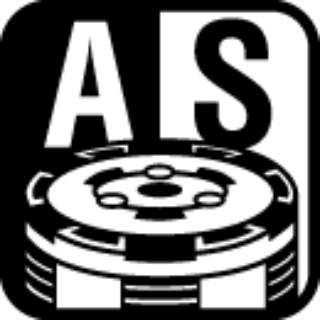
Based on feedback from racing activities, the Assist & Slipper Clutch uses two types of cams (an assist cam and a slipper cam) to either drive the clutch hub and operating plate together or apart. Under normal operation, the assist cam functions as a self-servo mechanism, pulling the clutch hub and operating plate together to compress the clutch plates. This allows the total clutch spring load to be reduced, resulting in a lighter clutch lever feel when operating the clutch. When excessive engine braking occurs as a result of quick downshifts (or an accidental downshift) the slipper cam comes into play, forcing the clutch hub and operating plate apart. This relieves pressure on the clutch plates to reduce back-torque and helps prevent the rear tyre from hopping and skidding. This race-style function is particularly useful when sport or track riding.
Smartphone connectivity contributes to an enhanced motorcycling experience by enabling riders to connect to their motorcycle wirelessly.

Clever technology enables riders to connect to their motorcycle wirelessly. Using the smartphone application RIDEOLOGY THE APP a number of instrument functions can be accessed, contributing to an enhanced motorcycling experience. Vehicle information (such as the odometer, fuel gauge, maintenance schedule, etc) can be viewed on the smartphone. Riding logs (varies by model, but may include GPS route, gear position, rpm, and other information) can be viewed on the smartphone. When connected, telephone (call, mail) notices are displayed on the instrument panel. Riders can also make changes to their motorcycle instrument display settings (preferred units, clock and date setting, etc) via the smartphone. And on certain models, it is even possible to check and adjust vehicle settings (such as Rider Mode, electronic rider support features, and payload settings) using the smartphone.
ERGO-FIT is an interface system that allows a wide range of riders to feel at one with their machine.

Proper fit is key for rider comfort and control. However, the ideal fit varies from rider to rider, depending on their physical dimensions and riding style. ERGO-FIT is an interface system designed to allow riders to find their ideal riding position. Various points of the chassis interface (the handlebar, footpegs and seat, etc) can be adjusted through a combination of interchangeable parts and parts with adjustable positions. This enables a wide range of riders to find a riding position that offers both comfort and control. Feeling at one with their machine, they will be able to experience how Kawasaki machines are fun and rewarding to ride. *Adjustable parts and their range of adjustability vary by model.
The Economical Riding Indicator is a mark appearing on the instrument panel to indicate favourable fuel consumption, encouraging fuel efficient riding.

Using high-precision electronic control for engine management, Kawasaki models can achieve a high level of fuel efficiency. However, fuel consumption is greatly affected by throttle use, gear selection, and other elements under the rider's control. The Economical Riding Indicator is a function that indicates when current riding conditions are consuming a low amount of fuel. The system continuously monitors fuel consumption, regardless of vehicle speed, engine speed, throttle position and other riding conditions. When fuel consumption is low for a given speed (i.e. fuel efficiency is high), an "ECO" mark appears on the instrument panel's LCD screen. By riding so that the "ECO" mark remains on, fuel consumption can be reduced. While effective vehicle speed and engine speed may vary by model, paying attention to conditions that cause the "ECO" mark to appear can help riders improve their fuel efficiency – a handy way to increase cruising range. Further, keeping fuel consumption low also helps minimise negative impact on the environment.
ABS (Anti-lock Brake System) ensures stable braking performance by preventing wheel lock during braking.

Sudden over-application of the brakes, or braking on low-grip surfaces (surfaces with a low coefficient of friction) such as wet asphalt or manhole covers may cause a motorcycle's wheel(s) to lock up and slip. ABS was developed to prevent such incidents. Kawasaki ABS systems are controlled by high precision and highly reliable programming formulated based on thorough testing of numerous riding situations. By ensuring stable braking performance, they offer rider reassurance that contributes to greater riding enjoyment. And to meet the special requirements of certain riders, specialised ABS systems are also available. For example, KIBS (Kawasaki Intelligent anti-lock Brake System) is a high-precision brake system designed specifically for supersport models, enabling sport riding to be enjoyed by a wider range of riders. And by linking the front and rear brakes, K-ACT (Kawasaki Advanced Coactive-braking Technology) ABS provides the confidence to enjoy touring on heavyweight models. Kawasaki is continually working on the development of other advanced ABS systems.
KIPASS (Kawasaki’s Intelligent Proximity Activation Start System) is a master key system that allows remote activation of the bike’s main switch and steering lock.
With the compact key fob (portable immobiliser) in a pocket, KIPASS allows riders to remotely release the bike's steering lock and main switch simply by approaching the bike. When the fob key is close to the bike, the signal it sends out is picked up and recognised by the KIPASS unit in the bike. Like immobiliser keys, each fob key has a unique signal, making this system also useful as a theft deterrent. The fob key can be recognised when in a jacket pocket, so there is no need for the rider to remove the key to operate the bike's main switch. Pannier cases and fuel tank cap are opened using the knob key inside the key cylinder. Because the knob key cannot be removed when the key fob is out of range, the keyhole is never visible, helping to prevent tampering. This system uses the encryption algorithm "MISTY" developed by MITSUBISHI ELECTRIC CORPORATION.
Based on racing technology, the Assist & Slipper Clutch acts as both a back-torque limiter and a self-servo mechanism that enables a lighter clutch lever pull.

Based on feedback from racing activities, the Assist & Slipper Clutch uses two types of cams (an assist cam and a slipper cam) to either drive the clutch hub and operating plate together or apart. Under normal operation, the assist cam functions as a self-servo mechanism, pulling the clutch hub and operating plate together to compress the clutch plates. This allows the total clutch spring load to be reduced, resulting in a lighter clutch lever feel when operating the clutch. When excessive engine braking occurs as a result of quick downshifts (or an accidental downshift) the slipper cam comes into play, forcing the clutch hub and operating plate apart. This relieves pressure on the clutch plates to reduce back-torque and helps prevent the rear tyre from hopping and skidding. This race-style function is particularly useful when sport or track riding.
Smartphone connectivity contributes to an enhanced motorcycling experience by enabling riders to connect to their motorcycle wirelessly.

Clever technology enables riders to connect to their motorcycle wirelessly. Using the smartphone application RIDEOLOGY THE APP a number of instrument functions can be accessed, contributing to an enhanced motorcycling experience. Vehicle information (such as the odometer, fuel gauge, maintenance schedule, etc) can be viewed on the smartphone. Riding logs (varies by model, but may include GPS route, gear position, rpm, and other information) can be viewed on the smartphone. When connected, telephone (call, mail) notices are displayed on the instrument panel. Riders can also make changes to their motorcycle instrument display settings (preferred units, clock and date setting, etc) via the smartphone. And on certain models, it is even possible to check and adjust vehicle settings (such as Rider Mode, electronic rider support features, and payload settings) using the smartphone.
ERGO-FIT is an interface system that allows a wide range of riders to feel at one with their machine.

Proper fit is key for rider comfort and control. However, the ideal fit varies from rider to rider, depending on their physical dimensions and riding style. ERGO-FIT is an interface system designed to allow riders to find their ideal riding position. Various points of the chassis interface (the handlebar, footpegs and seat, etc) can be adjusted through a combination of interchangeable parts and parts with adjustable positions. This enables a wide range of riders to find a riding position that offers both comfort and control. Feeling at one with their machine, they will be able to experience how Kawasaki machines are fun and rewarding to ride. *Adjustable parts and their range of adjustability vary by model.
The Economical Riding Indicator is a mark appearing on the instrument panel to indicate favourable fuel consumption, encouraging fuel efficient riding.

Using high-precision electronic control for engine management, Kawasaki models can achieve a high level of fuel efficiency. However, fuel consumption is greatly affected by throttle use, gear selection, and other elements under the rider's control. The Economical Riding Indicator is a function that indicates when current riding conditions are consuming a low amount of fuel. The system continuously monitors fuel consumption, regardless of vehicle speed, engine speed, throttle position and other riding conditions. When fuel consumption is low for a given speed (i.e. fuel efficiency is high), an "ECO" mark appears on the instrument panel's LCD screen. By riding so that the "ECO" mark remains on, fuel consumption can be reduced. While effective vehicle speed and engine speed may vary by model, paying attention to conditions that cause the "ECO" mark to appear can help riders improve their fuel efficiency – a handy way to increase cruising range. Further, keeping fuel consumption low also helps minimise negative impact on the environment.
ABS (Anti-lock Brake System) ensures stable braking performance by preventing wheel lock during braking.

Sudden over-application of the brakes, or braking on low-grip surfaces (surfaces with a low coefficient of friction) such as wet asphalt or manhole covers may cause a motorcycle's wheel(s) to lock up and slip. ABS was developed to prevent such incidents. Kawasaki ABS systems are controlled by high precision and highly reliable programming formulated based on thorough testing of numerous riding situations. By ensuring stable braking performance, they offer rider reassurance that contributes to greater riding enjoyment. And to meet the special requirements of certain riders, specialised ABS systems are also available. For example, KIBS (Kawasaki Intelligent anti-lock Brake System) is a high-precision brake system designed specifically for supersport models, enabling sport riding to be enjoyed by a wider range of riders. And by linking the front and rear brakes, K-ACT (Kawasaki Advanced Coactive-braking Technology) ABS provides the confidence to enjoy touring on heavyweight models. Kawasaki is continually working on the development of other advanced ABS systems.
| Engine type | Liquid-cooled, 4-stroke, parallel twin |
|---|---|
| Compression ratio | 11.3:1 |
| Valve system | DOHC, 8 valves |
| Bore x stroke | 70.0 x 58.6 mm |
| Displacement | 451 cm³ |
| Fuel system | Fuel injection: 32 mm x 2 |
| Lubrication | Forced lubrication, wet sump |
| Starting system | Electric |
| Ignition system | Digital |
| Maximum power | 33.4 kW {45.4 PS} / 9,000 rpm |
|---|---|
| Maximum torque | 42.6 N•m {4.3 kgf•m} / 6,000 rpm |
| CO2 emission | 89 g/km |
| Fuel consumption | 3.8 l/100km |
| Transmission | 6-speed, return shift |
| Clutch | Wet, multi disc |
| Primary reduction ratio | 2.029 (69/34) |
| Gear ratios 1st | 2.929 (41/14) |
| Gear ratios 2nd | 2.056 (37/18) |
| Gear ratios 3rd | 1.619 (34/21) |
| Gear ratios 4th | 1.333 (32/24) |
| Gear ratios 5th | 1.154 (30/26) |
| Gear ratios 6th | 1.037 (28/27) |
| Final drive | Sealed chain |
| Final reduction ratio | 3.071 (43/14) |
| Frame type | Trellis, high-tensile steel |
|---|---|
| Trail | 92 mm |
| Wheel travel front | 120 mm |
| Wheel travel rear | 130 mm |
| Tyre, front | 110/70R17 M/C 54H |
| Tyre, rear | 150/60R17 M/C 66H |
| L x W x H | 1,995 x 730 x 1,120 mm |
| Steering angle L R | 35° / 35° |
| Wheel base | 1,375 mm |
| Ground clearance | 145 mm |
| Fuel capacity | 14.0 litres |
| Seat height | 785 mm |
| Curb mass | 172 kg |
| Front brake type | Single semi-floating disc |
|---|---|
| Front brake diameter | Ø 310 mm |
| Front brake caliper type | Balanced actuation dual-piston |
| Rear brake type | Single disc |
| Rear brake diameter | Ø 220 mm |
| Rear brake caliper type | Dual-piston |
| Front suspension type | Telescopic fork |
| Front suspension diameter | Ø 41 mm |
| Rear suspension type | Bottom-link Uni-Trak, gas-charged shock, and spring preload adjustability |
Inpage Navigation Section: Accessories
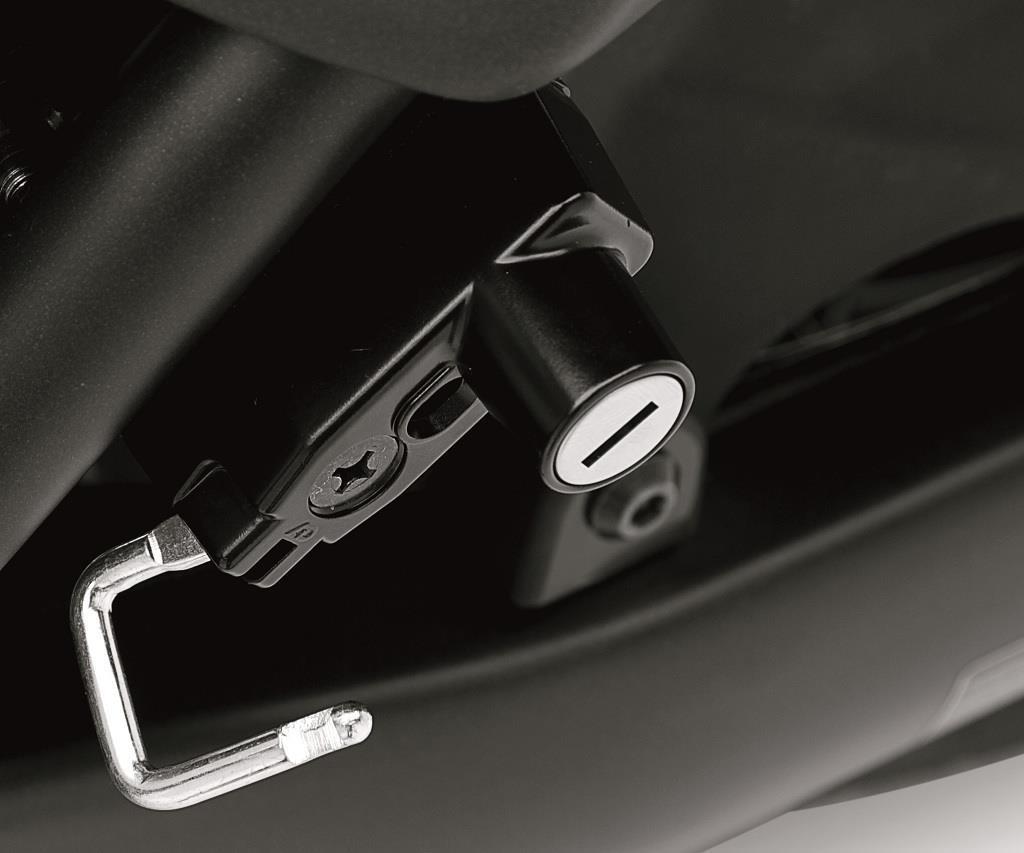
Conveniently lock your helmet when you’re off the road.
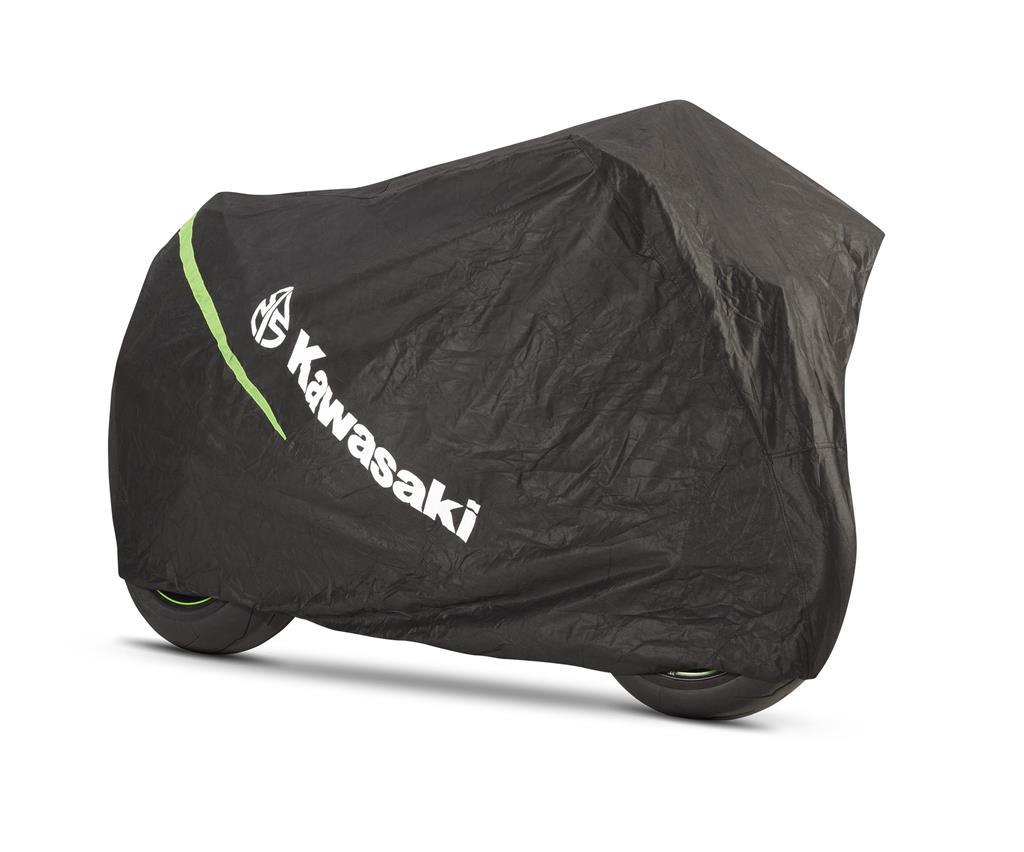
Bike cover made from breathable heavy-duty non-woven ripstop material. Kawasaki specific with green honeycomb design elements Easy reach lock buckle. 100% Polyester. With multi usable storage bag.
Read More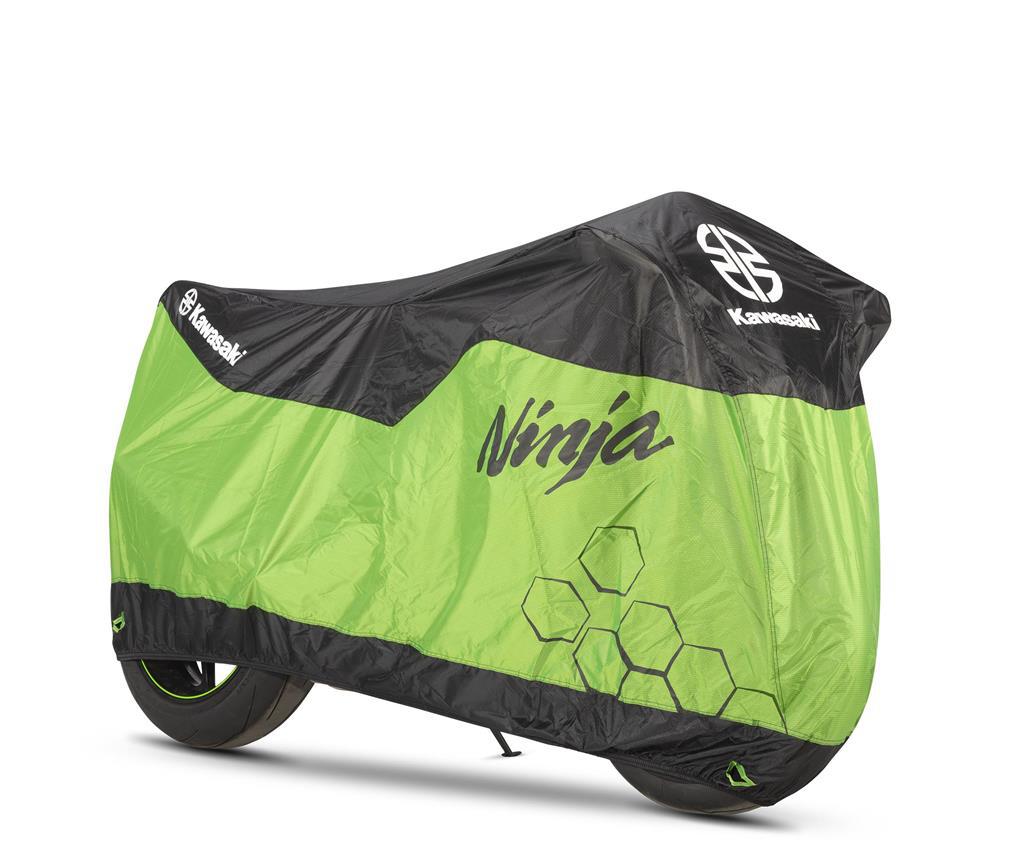
Made from strong Anti-tear Honeycomb ripstop fabric. Heat resistance till 120 degrees Celcius. Subtle branding.
100% Polyester. With multi usable (back)packing string bag.
Fits:

Give your Kawasaki bike a more sporty look and sound with this Akrapovič slip-on system. This lightweight slip-on system offers great performance. The combination of racing materials like titanium for the muffler outer sleeve and carbon fiber end cap give this exhaust system a racing touch. The heatshield is included. This homologated exhaust system is compliant with Euro5+ regulations (emissions and noise) and has EC type-approval.
Read More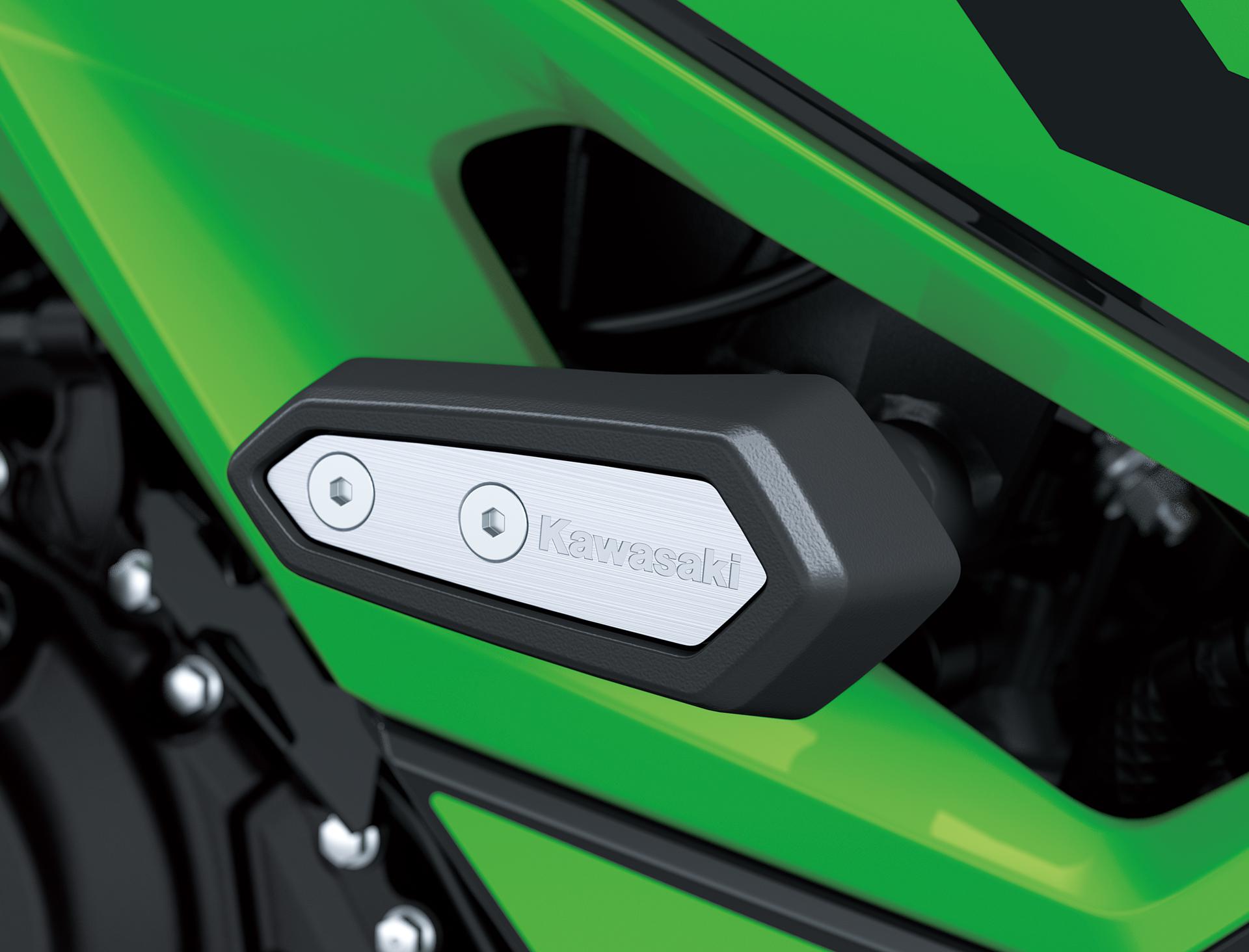
Help protect your motorcycle from tip-over damage.
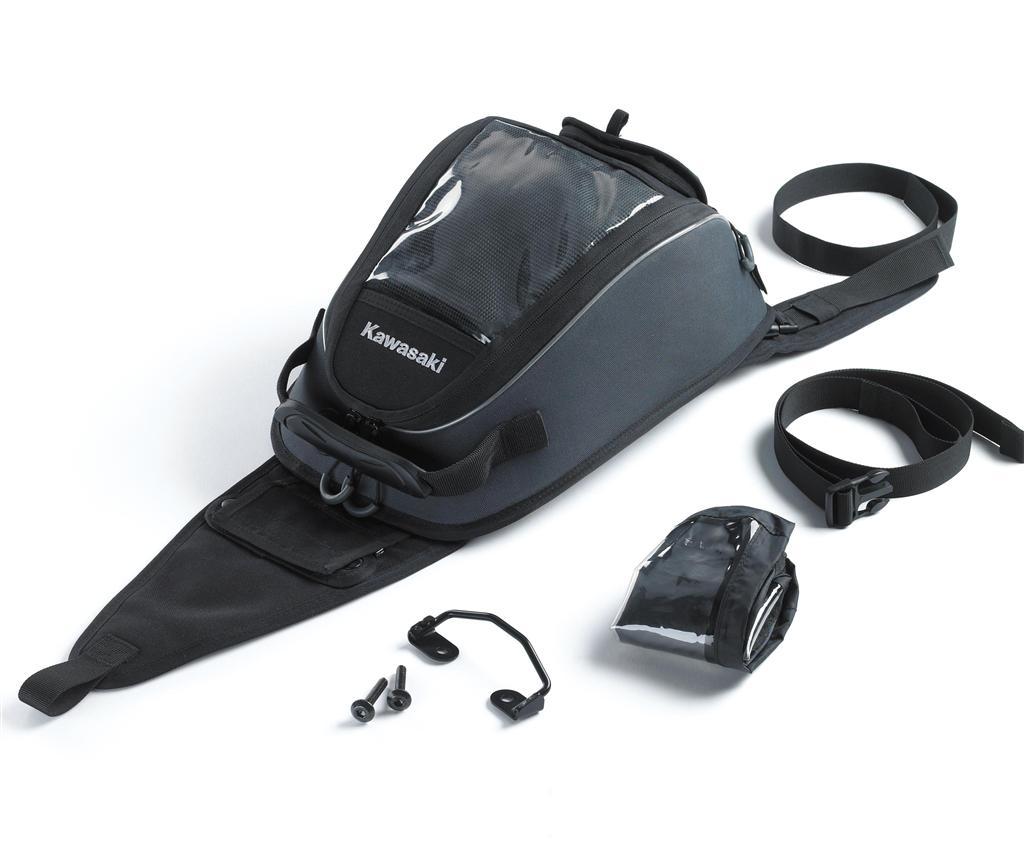
Semi rigid Nylon tank bag specially designed for the fuel tank shape.
Black/Grey tank bag with reflective piping and Kawasaki logo.
Pocket with transparent plastic window at top of tank bag with hole for earphone.
Inside has partitions to prevent goods moving around.
Including shoulder belt and rain cover with transparent window.
L350mm, W223mm,H150mm
Load Weight Max 2kg
Load Capacity approximate 4 Litre.
A matching bracket is required for fitment.
An essential tool for motorcycle enthusiasts and mechanics alike. Designed to provide stability and convenience, this paddock stand allows easy access to the wheels, suspension, and other components.
This premium rear bike stand can be disassembled, making transportation a lot easier. The compact bike stand comes in a shop worthy carrying case with a built-in carrying handle. The stand is made of premium steel and has a green and black finish. The Kawasaki logo is laser cut in steel.
Optional are the forks to suit your preference;
